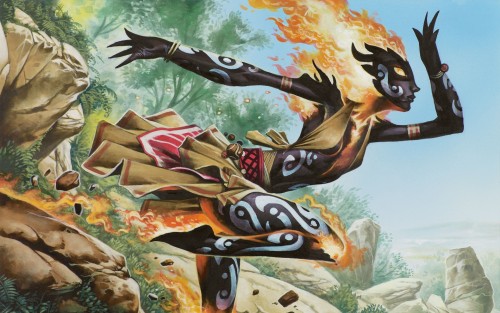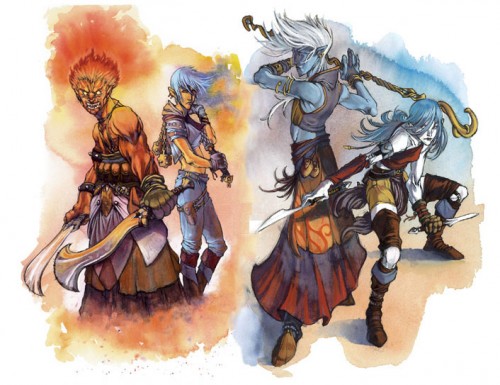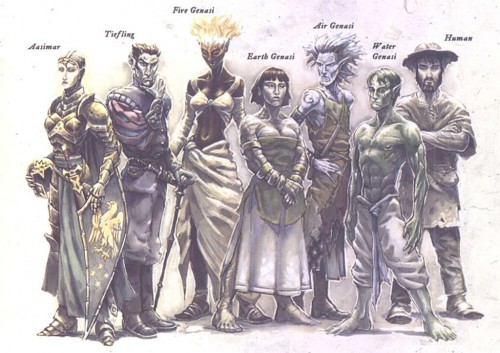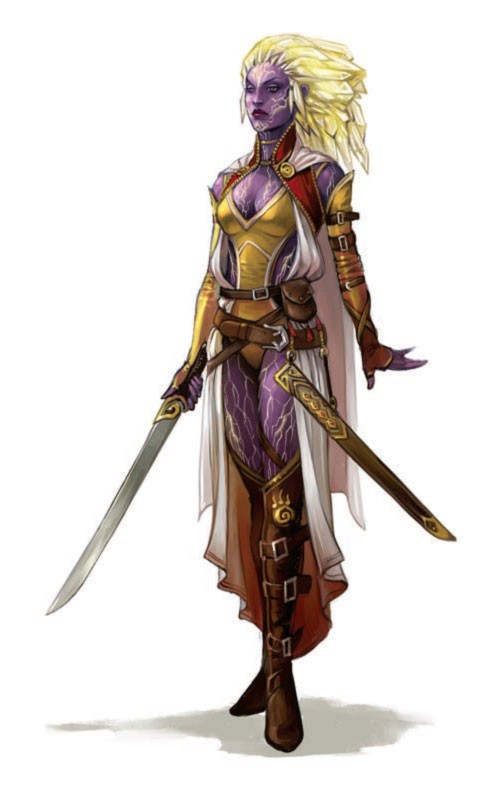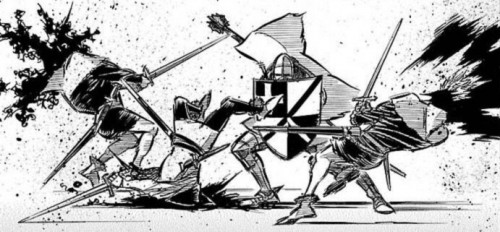
In which the author rambles incoherently about the Champion Fighter Archetype as found in Type V Dungeons & Dragons.
Looking at the Champion archetype in comparison to its counterparts the Battle Master and the Eldritch Knight, particularly from a character optimization mindset, it doesn’t have a lot to recommend it. The Battle Master’s superiority dice allow you to bump up damage several times per short rest and achieve tactically-interesting results on top of dealing normal weapon damage. The Eldritch Knight has access to the low end of the Wizard spell list. All three have the core Fighter features of multiple attacks, good weapon and armor proficiencies, good hit points, and the Action Surge. What is the Champion bringing to the table that recommends it for selection?
Level 3: Improved Critical
Normally you only land a critical hit on a natural 20, that’s 5% of all rolls. With advantage it’s closer to 9%. A 3rd-level Champion scores a critical hit on a 19 or 20, 10% of rolls. With advantage that bumps up to about 19%. Granted, a critical hit isn’t always that impressive. A longsword dealing 1d8+3 damage (7.5 average) instead deals 2d8+3 damage (12 damage). A difference of 4.5. Happening 10% of the time, that’s an upswing of under half a hit point per swing. Combine this with the Great Weapon Master feat and a critical hit buys you a bonus action to attack again, which makes this feature a bit more appealing if you’re swinging a big hunk of weapon with both hands. Compared to the Battle Master’s maneuvers, which grab an extra 1d8 damage on a hit four times per short rest, plus another effect, just at the moment when you want it to, and it’s just not impressive at all.
Critical hits occur more often if we attack more often, so fighting with two weapons increases our odds somewhat. At 3rd level a Champion wielding two shortswords will land at least one critical hit every five combat rounds compared to a Battle Master two-weapon fighter landing one every ten. You can use the Great Weapon fighting style and the Polearm Master feat to get two attacks per round, one at 1d10 and one at 1d4, landing a critical at twice the normal rate and re-rolling 1’s and 2’s on the dice. Against an opponent with a 15 AC, a reasonably-put-together Polearm Master Champion would be doing 9.209 damage per round on average. By comparison a Polearm Master Eldritch Knight would be doing 8.88 damage against the same target. Four times per short rest, already knowing whether a critical applied or not, a Battle Master could add a superiority die to the mix, doing an extra 2d8 damage on that blow. If he were to consistently keep a die reserved for that purpose, his average damage bumps up to a little over 9.78 per round.
Given the opportunities provided by magical armament, some items add more dice to the weapons’ damage. These dice are also doubled on a critical hit, so a Champion with a Flametongue Longsword would deal 2d8+4d6 damage 10% of the time, improving the bang for her buck. If you could get your hands on a Flametongue Glaive, you could deal 2d10+4d6 on a critical hit with the main end and 2d4+4d6 with the other end. A 3rd level Champion with a Flametongue longsword attacking an opponent with AC 15 deals 11.535 damage per round. The Eldritch Knight, meanwhile, does 11.075 damage per round. The Battle Master dials it up to 11.525, just under the raw average output of the champion.
Arranging for advantage nearly doubles the odds of landing a critical hit, so off-label combat actions like grappling and shoving (to knock down) are somewhat more valuable to a Champion than to other Fighters. One such option is the Shield Master feat, which grants a bonus action that can be used to shove (abused somewhat by characters like the Savage Duelist). Taking from the Flametongue example above, using the Shield Master feat to knock an opponent prone grants advantage and shifts the Champion up to 16.885, the Eldritch Knight up to 15.205, and the Battle Master to 16.545. Here we see the Champion narrowly eking out an edge in the numbers game. Note that the Eldritch Knight has cantrips and couple 1st level spells to round things out, and the Battle Master’s maneuvers offer additional tactical effects and are essentially dealing identical damage over time. Over twenty rounds of combat the difference is only 6.8 hit points.
Find a way to get an additional attack, additional dice, and advantage consistently and you’re in business. That’s a lot of factors to jam together.
Level 7: Remarkable Athlete
This is basically a limited-purpose Jack of All Trades feature from the Bard class. You get half your proficiency bonus (rounded up) added to any Strength, Dexterity, or Constitution check you make that doesn’t already have a proficiency bonus added in. When you get this feature at 7th level it’s worth a +2. Most things you’re going to make ability checks for could already be covered by a skill, skills that you may have already been proficient with. Did you want to wait until 7th level to be pretty good at several tasks? I didn’t think so. But like Jack of All Trades this applies to Initiative checks, too, which makes it handy in a limited context. It also lets you jump a little further.
To get the most out of this feature we would want to eschew Strength and Dexterity-based skills for the first six levels of our adventuring career. What kind of character would do that? Somebody from a more hifalutin background than we might normally associate with the Fighter class. Several backgrounds lend themselves very well to more erudite, delicate character classes than the Fighter, but if you’re looking to create a sword-wielding adventurer from a more sedentary upbringing, the Champion can help smooth out some rough spots in your skill arsenal. Consider a Guild Artisan or Acolyte with no magical proclivities striking out into the world on some important calling. As she progresses in her adventuring career she finally gets the hang of all this skulking about and scaling cliffs and cartwheeling past foes, and finally gets over a little hesitation that was holding her back. At 7th level she’s out of her shell and surprising her allies with a bolder outlook complete with initiative bonuses and derring-do.
Compared to a Battle Master gaining one superiority die and the ability to size up an opponent, this is quite good if handled right. The Eldritch Knight meanwhile has gone on to casting 2nd level spells and can opt to cast a cantrip and attack during the same round instead of just casting a spell or just attacking twice.
Level 10: Additional Fighting Style
All Fighters get a fighting style at first level, but the Champion alone gets a second style at 10th level. Most of the styles don’t compliment each other simultaneously; you don’t get your +2 damage from Dueling and +2 to attack from Archer for the same attack. You can simultaneously benefit from Defense and any of the others, and Protection is even better with a second style than it is by itself.
Great Weapon + Archer is a lovely way to round out your tactical usefulness. A bonus to attack with ranged weapons. Insulation from bad damage rolls in melee. Note that the Great Weapon re-rolls apply to the extra dice on critical hits, so this compliments the Improved Critical feature as well.
Dueling + Defense is a mildly cheesy way to top of armor class. With plate armor and a shield, you would have a 21 armor class before any magical benefits your equipment confers. The Dueling style helps you keep up on damage output compared to your greatweapon-swinging buddies even while you’re harder to hit than any Monster Manual creature under Challenge Rating 20.
Two-weapon Fighting + Protection is an attempt to get as many actions as possible during a round, providing a reliable bonus action attack without spending a feat as well as an additional use to put your reactions to. One action, one bonus action, one reaction. In the 5th Edition action economy, that’s as good as you’re going to get. Your allies will appreciate bad-guys rolling at disadvantage, too.
By comparison, the Eldritch Knight applies a conditional disadvantage on spell saving throws and the Battle Master gets bigger superiority dice and two more maneuvers. Keep in mind that these are maneuvers he didn’t think were worth acquiring earlier, so they’re not that good. Again the Champion got a somewhat superior feature.
Level 15: Superior Critical
We go from a 10% critical hit chance to 15%. With advantage it’s nearly 30%. At 15th level the Champion Fighter is hitting just right an awful lot. You take maximum advantage of this feature in the same way as with the Improved Critical. More attacks, more damage dice, advantage on attack rolls.
By comparison, the Eldritch Knight gains the ability to teleport 30′ when using his Action Surge, which is potentially awesome. At this point he’s got 3rd level spells like Fireball, which are always crowd-pleasers. The Battle Master gets an extra superiority die and a means of recovering one at the beginning of every battle if he was already spent. Not so great.
Level 18: Survivor
When starting your turn under 1/2 your maximum hit points, automatically recover some hit points. This is more a means of saving somebody else’s spell slots between battles than a save-ass toughness thing. By the time you get this feature anything that would get you to under 1/2 your hit points is likely hitting you much, much harder than this heals.
Don’t plan on taking a character archetype in hopes of getting tons of use out of an 18th-level class feature. Your character will be long dead, the campaign long abandoned before you get this far, so don’t peg your hopes and dreams on recovering 5+(Con modifier) damage every round. At this level the Eldritch Knight can cast a spell and still take a single attack. For 18th level this is thoroughly unimpressive. The Battle Master get d12s for his superiority dice, upping their average value from 4.5 when he first got them to 6.5. Also underwhelming.
The Verdict
The Champion starts off with a pretty weak feature set that gets incrementally better as the character advances in levels. If you’re looking to create a character that grows from zero to hero, this archetype may work well for you, particularly if you think she may branch out to explorer other areas of expertise through multiclassing. There’s synergy to be found between the Fighter’s extra attribute improvements to have a character improve organically, becoming stronger, faster, tougher, smarter, etc. in keeping with the events unfolding in play as opposed to some grand master plan. The Second Wind, Action Surge, and Indomitable class features lend themselves to this as well, drawing upon raw inner reserves to accomplish great things where other characters rely on specialized training or magic.
I would consider the Champion archetype a good core component to an adventuring-detective character, likely paired with the Thief archetype for skill expertise. Here’s a possible D&D Jessica Fletcher:
| Dungeon, She Wrote |
Rock Gnome Champion 7 / Thief 3
Sage Background
Lawful Nosy
| Attribute |
Value |
Bonus |
Save |
| Str |
15 |
+2 |
+5 |
| Dex |
13 |
+1 |
+1 |
| Con |
10 |
+0 |
+3 |
| Int |
16 |
+3 |
+3 |
| Wis |
15 |
+2 |
+2 |
| Cha |
10 |
+0 |
+0 |
Skills: Arcana (+6), History (+6), *Insight(+8), *Investigation(+9), Perception (+5), Artisan’s Tools (tinker’s tools), Thieves’ Tools
Languages: Common, Dwarven, Elvish, Gnomish
Hit Points: 61
Armor Class: 21 (Plate + Shield + Fighting Style)
Initiative: +3
Speed: 25
Weapons: Rapier (+5 to attack, 1d8+2 damage) twice
Other notable features: Advantage on Int/Wis/Cha saves vs. magic, Darkvision 60′, Artificer’s Lore, Tinker, Researcher, Fighting Style (Defense), Second Wind (1d10+7), Action Surge, Ability Score Improvement (Str), Extra Attack, Ability Score Improvement (Observant Feat), Remarkable Athlete, Expertise (Insight, Investigation), Sneak Attack (2d6), Thieves’ Cant, Cunning Action, Fast Hands
|

